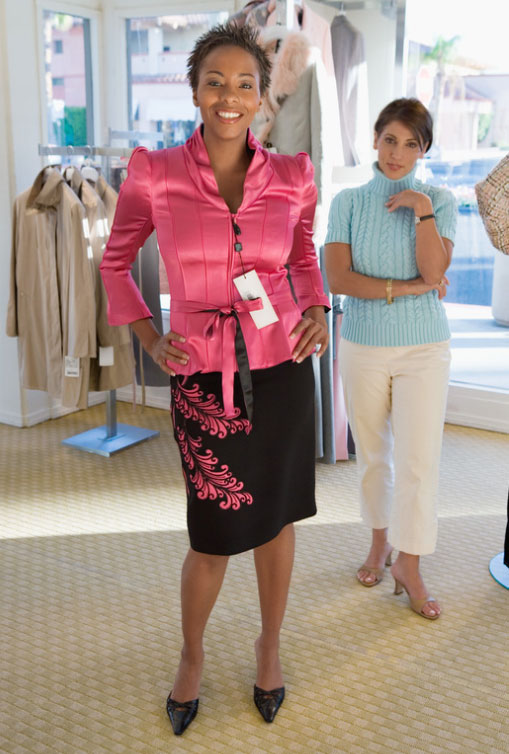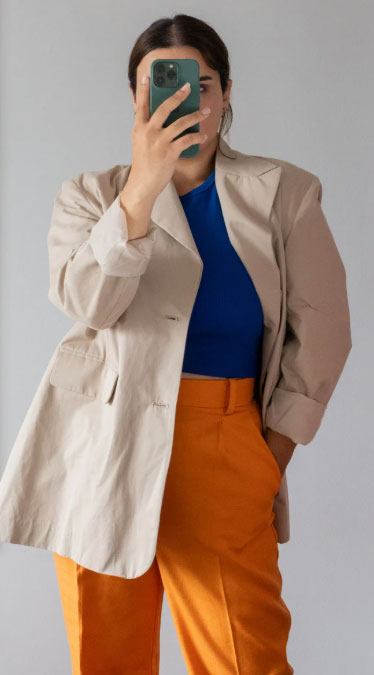A Dressing room in a store is designed to create an optimized, temporary impression of how you look. Put an end to the dressing room trap by trying these 4 strategic steps from an image consultant.
The Dressing Room Illusion: An Image Consultant Reveals Why Your Clothes Lie
Have you ever brought home a purchase only to feel total buyer’s remorse the next morning? That feeling is incredibly common, and it happens because of the stark differences between a store’s controlled environment and your home’s reality. As a Boston personal stylist, I see this trap claim brilliant pieces all the time. But once you know the tricks, you can shop smarter and avoid future regret.
The Great Illusion of the Dressing Room: Lighting, Mirrors, & Psychology

Dressing rooms are strategically designed to create an optimized, temporary impression of how you look. It’s a calculated effort to boost your confidence and encourage the purchase.
- Manipulative Lighting: Retailers intentionally use soft, warm, diffused light sources placed around the mirror. Instead of a single, unforgiving overhead light, many fitting rooms use vertical sconces or side-mounted LED strips to cast light evenly across your body. This minimizes shadows under the eyes and on the midsection, creating a slimmer, more uniform look. In contrast, your home overhead lighting is likely much harsher and exposes flaws.
- Flattering Mirrors: Many store mirrors have a slight curve or tilt that makes you appear longer and leaner than a typical flat home mirror. Some mirrors even use subtle tints to give your skin a vibrant, healthy glow.
- The Halo Effect: When you’re shopping, the sheer excitement of finding something new can boost your mood and confidence. This “halo effect” makes you perceive yourself and the outfit much more positively than you would in the familiar, everyday context of your home. As an image consultant, I know that our mood is one of the biggest factors in shopping regret!
The Reality Check: Contextual Traps of the Dressing Room

The deception isn’t just about the physical space; it’s also about the mental context of your purchase.
- Aspirational Disconnect: You may be buying clothes for an aspirational lifestyle rather than your current one. That luxurious silk dress might look fantastic in the shop, but it feels out of place for your routine at home, leading to buyer’s remorse. When working on a wardrobe makeover, we focus on pieces that fit your actual life.
- Color Confusion: Dressing rooms use neutral backgrounds to prevent any wall color cast from interfering with the true color of your clothes. At home, your wall color and natural light can drastically affect how you perceive the garment’s shade, often throwing off your planned color combinations.
- Impulse Buying: That emotional rush of finding a “bargain” or “must-have” item can lead to impulsive purchases. This high fades once you get home, leaving you to question your choice based on logic, not emotion.
Stop Buyer’s Remorse: 4 Strategic Steps from an Image Consultant

If you’re ready to put an end to the dressing room trap, try these four simple strategies before you buy:
- Take a Photo: Before leaving the room, take a full-length photo with your phone’s camera. The camera’s flash and perspective will give you a less-biased, truer view than the tilted mirror.
- Check the Fit in Different Lighting: If possible, step just outside the dressing room to see the garment in the store’s regular lighting. Better yet, find a window to see how it looks in natural light—that’s the truest test.
- Consult Your Existing Wardrobe: When you find an item you like, immediately think of at least two or three specific outfits you can create with pieces you already own. If it doesn’t match anything, it’s a high-risk purchase.
- Wait and Reflect: If you’re unsure, try waiting an hour or even a day before making the purchase. This reduces the emotional effect of impulse buying and allows you to make a more logical, considered decision.
If tackling this trap feels like too much work, professional personal styling services can be a game-changer. As a fashion stylist and wardrobe consultant, I specialize in teaching you how to build a smart, cohesive wardrobe that makes you feel confident every single day.
Style Fix Studio offers a range of personal styling services for men and women, such as Free Initial Personal Styling Consultation with a Certified Personal Stylist, Closet Audit, Color Analysis, Personal Shopping with a Try-on Session, Wardrobe Makeover, Total Image Makeover Services for all ages, Plus Size Styling and Online Personal Styling. Contact Style Fix Studio today to schedule a consultation with a professional personal stylist in Boston, MA. Transform your look, transform your life!


